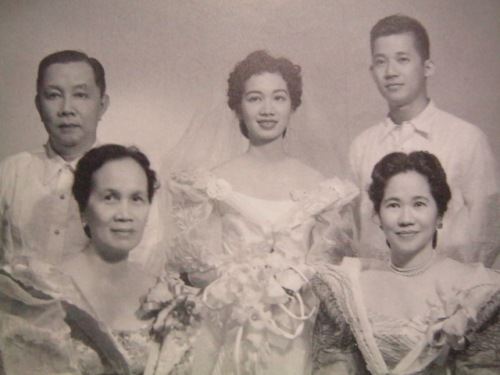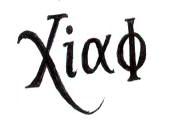THE KAPAMPANGAN POWER-COUPLE WHO ROCKED THE WORLD (For Cory Aquino’s 80th Birth Anniversary)
by xiaochua
This, my take and summary of Ninoy and Cory Aquino’s significance in our history, in the writing of which I gave my very best, was written at the request of The Juan D. Nepomuceno Center for Kapampangan Studies, Holy Angel University for inclusion in Singsing 6 (1): 204-207, edited by Robert Tantingco and published in 2012. The issue of the Kapampangan cultural magazine had the theme “Bravehearts: Kapampangan Rebels, Radicals & Renegades Who Changed Philippine History.” Posted in this website in commemoration of Cory Aquino’s 80th birth anniversary.
“Well, I always say that Ninoy and I were able to bring the best in each other. And I think that’s all that’s necessary for a married couple. To try to bring out the best in each other.”
-Cory Aquino to Xiao Chua and classmates, 2003
Years after playing their part in a theatre called Philippine History, Ninoy and Cory Aquino are still the subject of debates in academic discussions and even facebook and twitter posts. Considered icons of democracy and heroism, Ninoy and Cory are now the object of revisionist attempts to denigrate their contribution to our struggle for freedom, especially in the cyber world: That Ninoy was a traditional politician, the same as Ferdinand Marcos, and that the two were actually very good friends to the end, fooling the country with their charade. That Cory was a weakling, who hid herself in the safety of a Cebu convent during People Power, playing absolutely no part in it. That the couple were non-heroes who actually destroyed the Marcos dictatorship which was the most democratic and peaceful time in Philippine history.
The milieu of the childhood of Benigno S. Aquino, Jr. (born 1932) and Corazon Sumulong Cojuangco (born 1933) was the Kapampangan Tarlac political and economic elite circles. Both spoke Kapampangan and the two were actually childhood friends. If what they say is true that to be Kapampangan is to be cocky, then Ninoy would be the quintessential Kapampangan. It is not surprising that Cory’s first memory of Ninoy is this, “…Ninoy kept bragging he was a year ahead of me in school so I didn’t even bother to talk to him.” His self-assuring attitude is rooted in his dear father’s infamy as a collaborator to the Japanese during the war. He wanted to both clean the name of his father and to prove himself. Kapampangan Local Historian Lino Dizon said that Ninoy’s family gave away their land in Concepcion, Tarlac to the peasants, and Frankie Sionil Jose claimed that in later life Ninoy told him of his plans to distribute Hacienda Luisita itself.

Ninoy and Cory with their parents Jose Sr. and Demetria Cojuangco and Aurora Aquino during their wedding day, 11 October 1954.
His star rose fast, writing about a war at 17, brought down one of the greatest rebels in Philippine history, Luis Taruc at 22, and was holder of major posts in government as the youngest Mayor, Vice Governor, Governor and Senator in a span of about only 13 years! His official biographer Nick Joaquin did not even hide the fact that he was a bragger and sweet talker, very much reflected in all video footage of his speeches, even up to the very last interviews he did before he was shot. He was once bragging about his walky-talkies, Arab stallions, helicopters and his hacienda (not his, his wife’s) to foreign guests. As local leader, he was indeed a traditional politician by many accounts: a turncoat who used guns, goons and gold and who also worked with Kapampangan rebels to protect his interests. Close friends suggest that Marcos and Ninoy were actually very good friends and that sometimes Ninoy would supply Marcos, his fraternity brod, ammunitions to win elections. He was a charmer, who courted the prettiest ladies at that time like the actress Dorothy Jones (a.k.a. Nida Blanca) and Imelda Romualdez herself.

Ninoy, the public servant, with Cory and their children: Ballsy, Pinky, Noynoy and Viel. Photo by Dick Baldovino.
But this most ambitious politician, who aimed at the presidency in 1973, was humbled by his experiences in his seven years and seven-month detention at Fort Bonifacio as the very first political detainee when Martial Law was proclaimed, especially his one month solitary confinement in Fort Magsaysay where he claimed to have found God. His source of strength was Cory and his family, who brought him his favorite Kapampangan food in prison. He in turn would prepare for them chicken spread placed on toasted bread. He loved to eat and this was evident with his size. But Alvin Campomanes, who is doing his thesis on Ninoy said that the greatest evidence of Ninoy’s sincerity to fight Marcos, that they ceased being friends by Martial Law, was that he abandoned his love of food and fasted as a protest for 40 days. He almost died in the attempt and this was definitely not a stunt. He chose to suffer with the people and did all his best to fight for their freedom.
After the three happiest years as a family man while in exile in Boston, Massachusetts, he returned to Manila on 21 August 1983 knowing he can do something about the worsening situation in his country. Whether or not he still wanted to be president was beside the point; he willingly gave his life for the country. When he died, People Power—which had started even in the seventies with the heroism and martyrdom of a few thousand freedom fighters, including Ninoy himself when he was still in prison—intensified with the participation of millions in the struggle that eventually brought down the dictatorship in two years.
Cory, who used to be just by the side of her husband, took center stage, walking and talking in rallies. Boy, she could talk. And when it became apparent that Marcos was still strong and no opponent could actually beat him, she sacrificed her privacy and accepted the mantle of leadership of the opposition in the 1986 snap elections, even acquiring the services of the political consultancy group Sawyer Miller to improve her craft for the cause. Protesting the fraudulent conduct of the elections and her defeat, she called for a boycott rally at the Luneta against the better judgment of her advisers who feared that the people would not come, but a million came. According to Angela Stuart Santiago, if the EDSA Revolution did not happen, the government would still fall just because so many had stopped drinking Coke and San Miguel and had withdrawn their deposits from crony banks. People Power happened because Cory’s call for peaceful civil disobedience which was going on for about a week already, prepared the people for full participation in People Power. On the second day of the revolution, 22 February 1986, Cory insisted on returning to Manila from Cebu, being driven beside the tanks going to EDSA. On the third day, she insisted on going to EDSA where she briefly stayed with the people near Ortigas-POEA, a fact documented by newspapers accounts the next day. She didn’t have to be there because the people were already shouting her name, but she came nonetheless. The peaceful change of regime that moved Filipinos to show their best qualities in four days and was inspired by this Kapampangan couple, was imitated by other peoples freeing themselves from dictatorships in the next quarter of a century, calling their movements “People Power.”
Cory heard Ninoy predict that the next president who came after Marcos would have a very difficult job handling the country. It was like turning a broken car after using it. Little did she realize that she would be the one.
Although her administration was marred by different crises, like the unfortunate Mendiola Massacre of 1987, the human rights violations of the post-Marcos Armed Forces who probably had a hang-over of their heyday, the nine coup attempts that rocked her administration, the power crisis, the 1990 Luzon earthquake and the 1991 Mt. Pinatubo eruption which buried the Kapampangan region, she should be credited for facilitating the difficult task of opening the democratic space which paved way for the development of cyberspace and the proliferation of different NGO and volunteer groups who are now hand-in-hand in helping the less fortunate. She also made a strong front against military adventurists who wanted to grab power. Two decades of decay cannot be overturned overnight and a lot people realized that although hers was not a perfect presidency, she did her best as president. There was even a popular clamor for her to run again but she peacefully stepped down and passed the baton to her elected successor in 1992. She continued to play an active role as Citizen Cory, promoting micro-finance among the poor and playing a key role in different protest movements during her post-presidency until she died in 2009. She was no saint, and didn’t claim as such, but she was a staunch and true defender of the kind of democracy she knew and tried to stay personally incorrupt as a public official. The world recognized and admired her for it. The continued popularity and political stability in the presidency of their son Noynoy is a testament of how many Filipinos revere the memory of these two Kapampangans.

Citizen Cory never stopped defending the kind of democracy she knew. With Jojo Binay, Noynoy Aquino, Tito Guingona and Rafael Lopa at Ayala Avenue.
Ninoy and Cory are two of the only few Filipino leaders known the world over. With their place in history secured more so even in demystification, this Kapampangan power-couple will continue to inspire countless others to share the light of their candles as they did, and to do what they can when they know they can.
23 September 2012, Ayala Museum, 40th anniversary of the announcement of Martial Law






